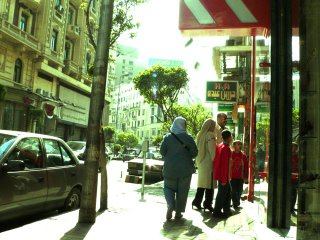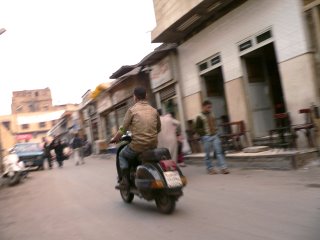Lo and behold, I live!
In spite of bombings in Dahab, where I actually considered spending some of spriing break, I live! Half of me wishes I was there while it happened, simply because of my curiosity - I realize that some may see that as wierd :|
Anyway; while I'm still here I might as well make a more detailed post.
Public transport in Cairo
Aside from taxis, driving yourself (hah!), riding a bike (hah! again) or walking, there are generally two ways of getting around in Cairo, the subway and all the different kinds of buses.
The subway is quick, clean and practical. As far as I know, it works in Cairo as it does everywhere else - you pay an insignificant amount of money to get a ticket (about 1kr) and then you can take the subway and move around inside the subway stations as much as you want until you get out. The subway is crowded (less so in the "no men allowed" car) but otherwise has a high standard.
The buses are the fun bit, however. There are no timetables, and bus stops tend to be poorly marked - but you can generally see where they are by looking for collections of people who look like they're standing at a busstop. Among these people you can usually find someone who looks young and educated enough to know english and ask this person for help. If you want to get somewhere, you will eventually get there if you just try hard enough (and since it's Cairo, it's no big deal if you go wrong as you can always grab a taxi).
There are three kinds of busses, the big "ordinary" buses, that are the size of normal buses, often airconditioned and not used by most people - these are the most expensive, sometimes costing as much as 2 guinea (almost 3 kroner). Then there are the minibuses, that are more popular and always full, and finally the microbuses, that are usually privately owned and often won't leave their first station without being full. A microbus is usually about the size of my dad's old Chrystler Voyager (and probably have to be repaired just as often) and it's a challenging but cheap way of getting around.
If you look confused enough people will always help you, and another sign of this community spirit and the trust it inspires is the way you pay on a bus. There is rarely an easy way of getting to the conductor, so the common way of paying is counting up the amount of money you're paying and giving it to the person in front of you. The money always reaches the conductor, and if you give too much, you'll always get your change sendt back the same way. I personally think people are generally as trustworthy as this back home as well, but maybe we're simply not as trusting of each other. I think maybe it would be better if we were.
In spite of bombings in Dahab, where I actually considered spending some of spriing break, I live! Half of me wishes I was there while it happened, simply because of my curiosity - I realize that some may see that as wierd :|
Anyway; while I'm still here I might as well make a more detailed post.
Public transport in Cairo
Aside from taxis, driving yourself (hah!), riding a bike (hah! again) or walking, there are generally two ways of getting around in Cairo, the subway and all the different kinds of buses.
The subway is quick, clean and practical. As far as I know, it works in Cairo as it does everywhere else - you pay an insignificant amount of money to get a ticket (about 1kr) and then you can take the subway and move around inside the subway stations as much as you want until you get out. The subway is crowded (less so in the "no men allowed" car) but otherwise has a high standard.
The buses are the fun bit, however. There are no timetables, and bus stops tend to be poorly marked - but you can generally see where they are by looking for collections of people who look like they're standing at a busstop. Among these people you can usually find someone who looks young and educated enough to know english and ask this person for help. If you want to get somewhere, you will eventually get there if you just try hard enough (and since it's Cairo, it's no big deal if you go wrong as you can always grab a taxi).
There are three kinds of busses, the big "ordinary" buses, that are the size of normal buses, often airconditioned and not used by most people - these are the most expensive, sometimes costing as much as 2 guinea (almost 3 kroner). Then there are the minibuses, that are more popular and always full, and finally the microbuses, that are usually privately owned and often won't leave their first station without being full. A microbus is usually about the size of my dad's old Chrystler Voyager (and probably have to be repaired just as often) and it's a challenging but cheap way of getting around.
If you look confused enough people will always help you, and another sign of this community spirit and the trust it inspires is the way you pay on a bus. There is rarely an easy way of getting to the conductor, so the common way of paying is counting up the amount of money you're paying and giving it to the person in front of you. The money always reaches the conductor, and if you give too much, you'll always get your change sendt back the same way. I personally think people are generally as trustworthy as this back home as well, but maybe we're simply not as trusting of each other. I think maybe it would be better if we were.




